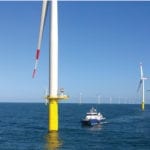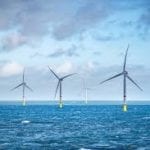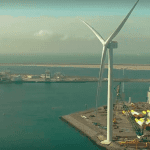Vineyard Wind’s 804-MW Park City project was given the go-ahead by Connecticut officials on Dec. 5, with regulators saying Vineyard’s bid in an offshore wind solicitation was “lower than any other publicly announced offshore wind project in North America.”
Vineyard Wind competed against other groups in the bidding, including developers backed by Ørsted and Shell. The company now will negotiate contracts with the state’s two major utilities, Eversource and United Illuminating Co.
The Park City development is considered the largest renewable energy project in Connecticut history. State officials said it could provide about 14% of the state’s electricity. The project’s turbines would be located south of Martha’s Vineyard and Nantucket, and would not be visible from Connecticut’s shoreline.
The project includes redevelopment of port facilities in Bridgeport Harbor. Vineyard Wind CEO Lars Thaaning Pedersen in a conference call on Thursday would not disclose the project’s cost, but the price for a similar Vineyard Wind project off the Massachusetts coast is about $3 billion. Vineyard, owned by Avangrid and Copenhagen Infrastructure Partners, won the first major U.S. offshore wind solicitation last year for that project, an 800-MW offshore wind farm sited south of Martha’s Vineyard.
The Massachusetts project was set for completion in 2022, but was delayed when federal officials said they wanted to conduct more environmental studies. Pedersen on Thursday said his company expects the Bureau of Ocean Energy Management will finish those studies “during the first half of 2020.”
“This [Bridgeport] project would be included in that cumulative impact study,” Pedersen said. “Once the programmatic review of offshore wind in a more general sense is concluded, we would expect that some of the challenges that we have faced with the first project will be already handled at a much earlier stage.”
Project Set to Come Online in 2025
The Connecticut project is expected to come online in 2025. Connecticut and other states have fast-tracked offshore wind solicitations in order for projects to take better advantage of a federal Investment Tax Credit, which has an uncertain future.
“All Connecticut residents will benefit from today’s selection of the Park City Wind Project,” Laura Morton, senior director for policy and regulatory affairs with the American Wind Energy Association, said in an email to POWER. “It will bring $890 million of direct economic development to Connecticut, including meaningful opportunities in the local supply chain and coastal communities like Bridgeport Harbor. As the lowest cost publicly announced offshore wind project in U.S. history, Park City Wind also proves we can power our homes and businesses with electricity that is both clean and affordable. Congratulations to Governor Lamont and Commissioner Dykes for their commitment to advancing the progress of the offshore wind industry and bringing the power of wind energy to the people of Connecticut.”
Several offshore wind projects are being developed off the East Coast, by companies including Vineyard Wind, Ørsted, Equinor, and Mayflower Wind, which is a joint venture of Shell New Energies and EDP Renewables. Dominion Energy is developing a 2.6-GW offshore wind project for Virginia, being built in phases, and expected to be fully online in 2026.
More auctions for offshore wind development zones are planned in 2020, including off the coasts of California and New York.
The Massachusetts project awarded Thursday includes redevelopment of an 18-acre waterfront property in Bridgeport called Barnum Landing. The area will serve as an offshore wind staging site and also feature an operations and maintenance center. Vineyard’s proposal includes an investment of about $900 million in the Bridgeport area. Bridgeport is the largest city in Connecticut.
Vineyard Wind’s Pedersen said he expects groundbreaking at the Bridgeport onshore site will occur in 2021, with that part of the project complete by year-end 2023. He said offshore construction, expected to take two years, will begin in 2023.
—Darrell Proctor is a POWER associate editor (@DarrellProctor1, @POWERmagazine).










